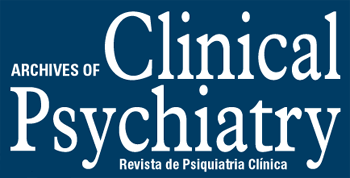Resumo em Português:
A síndrome da insuficiência androgênica na mulher (SIA) desperta, mesmo nos dias atuais, muitas discussões e encerra muitas controvérsias. Sabe-se, no entanto, que os níveis plasmáticos de testosterona declinam progressivamente ao longo do período reprodutivo. Conceitua-se a SIA como o conjunto de sintomas clínicos, a presença de biodisponibilidade diminuída de testosterona e os níveis normais de estrogênios. Entre os principais sintomas, citam-se o comprometimento do bem-estar, o humor disfórico, a fadiga sem causa aparente, o comprometimento do desejo sexual, o emagrecimento e a instabilidade vasomotora em mulheres pós-menopáusicas sob terapêutica estrogênica. Esses sintomas, no entanto, são potencialmente atribuíveis a diferentes etiologias e dificultam o correto diagnóstico na maioria dos casos, ainda que ele seja lembrado com freqüência em pacientes que se submetem à ooforectomia bilateral. O diagnóstico da SIA parece ser essencialmente clínico, não havendo a necessidade das dosagens laboratoriais para a sua comprovação. Não se deve indicar a terapêutica androgênica (TA) em pacientes que não estejam adequadamente estrogenizadas. Considera-se a testosterona o hormônio ideal para a TA. As pacientes com sintomas sugestivos de SIA, excluídas outras causas identificáveis, especialmente se pós-menopáusicas, são candidatas à TA. Não existem dados de segurança sobre a TA em usuárias em longo prazo. A via transdérmica - através de adesivos, cremes e gel - parece ser preferível à oral.
Resumo em Inglês:
The women’s androgen insufficiency syndrome (AIS) arises, even nowadays, many debates and clears a lot of controversies. It is known, however, that the plasmatic levels of testosterone gradually decline through the reproductive period. AIS is appraised as a set of clinical symptoms, bioavailability presence diminished of testosterone and normal levels of estrogen. Among the main symptoms that remind the diagnosis are the well-being impairment, dysphoric mood, the fatigue without apparent cause, the sexual desire impairment, the loss of weight and the vasomotor instability in postmenopausal women receiving estrogen. These, however, are potentially attributable to the different etiologies and make it difficult to give the correct diagnosis in the majority of the cases, even though it is reminded, often, in patients who submit to bilateral oophorectomy. The diagnosis of the SIA seems to be essentially clinical, not having the needs of laboratorial dosages for its proof. It shouldn’t indicate the androgenic therapy (AT) in patients without concomitant estrogen therapy. Testosterone is considered the ideal hormone for AT. Patients with suggestive SIA symptoms, excluded other identifiable causes, especially the post-menopauses ones, are candidates to AT. There are no safety data about AT in long stated period users. The transdermal patches, creams and gel seems to be preferable to the oral formulations.
